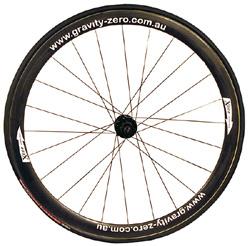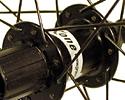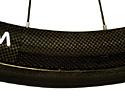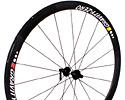
Recently on Cyclingnews.com |
On test: Gravity-Zero X One Wheels, February 23, 2006
No slacking!
Gravity-Zero wheels offer silent freewheeling and no take-up as you start pedalling thanks to a clutch mechanism that replaces the traditional pawl-and-sprocket freewheel. Jon Kenny takes a set for a spin.

|
Gravity-Zero is a small Australian company that has put its energies into eliminating the issue of cassette lag, the slight gap between initial pedalling and full engagement of the gears. The company contends that eradicating this lag provides riders with more torque and eliminates dead spots on the pedal stroke.
Cassette lag
Lag in the rear hub was not something that had given me too many sleepless nights, but provoked considerable interest when I was made aware of it. Try pedalling explosively from a standing start. Feel that slight slip before the torque gets transferred to the rear wheel? That lag robs you of a modest amount of torque that could be going into propelling the bike forwards. The delay is caused by pawls in the cassette body that sit on tiny springs at about a 45-degree angle, which allows them to flatten against the inner cup of the free hub body when freewheeling. It's the pawls that make the characteristic ratchet sound. The spring under each pawl pushes it upward toward the outer cup when pedalling. They then "bite" against the outer cup, locking in position so long as the pressure is maintained on the pedals, but they take a moment to engage.
Track riders on fixed wheel bikes do not experience this loss of torque and this is one of the reasons why track bikes feel so fast. All of the power generated by muscular track sprinters needs to get to the rear wheel quickly and a single gear does that job efficiently. In an ideal world, riders could gain the benefit of fixed-gear pedalling (the momentum of the bike helps to eliminate dead spots at the top and the bottom of the pedal stroke) and still have the luxury of gears. Stuart O'Grady rode a fixed-gear in the short opening time-trial of the 2005 Giro in order to lighten his bike and to take advantage of superior fixed-gear pedalling. There were a couple of key conditions that allowed O'Grady to sacrifice the luxury of gears, namely, the brevity of the test and the consistency of the terrain. Moreover, the experience and pedalling efficiency of a track-turned-road professional like O'Grady made the decision viable. Watch a tape of O'Grady's gold medal winning ride in the 2004 Olympic Madison race and you will see an example of a rider who knows how to spin a gear smoothly.
|
|
|
|
|
|
|
|
|
Generally though, cyclists need gears to counter variable terrain, air resistance and the vagaries of bunch racing, but what if there was an alternative to conventional cassette hubs that allowed some of the momentum-carrying benefit of riding a fixed wheel? That's where Gravity-Zero comes in.
X one hub system
Pawls slip by perhaps as much as 22.8° before take-up. Kevin Hancett of Gravity-Zero said that this is not the only problem with the system. "Normal cassette hubs have a dead spot at the top and the bottom of the pedal stroke, where the cassette disengages," he says. "Conventional hubs lose torque, as there is no momentum to carry the rider's legs over the dead spots at the top dead centre and the bottom dead centre." Hancett puts this down to the cyclist's legs not working together efficiently as muscle strength differs from the effort of pushing to lifting on the upstroke. Also, cyclists tend to have some variation in strength from leg to leg. Hancett says Gravity-Zero hubs are different as, "the GZ hub is live from assembly [so] both legs work together 100 per cent of the time within your pedal strokes and each one balances out the other. Zero lag then means the momentum throws each leg over the least mechanical advantage of the cranks at top dead centre and bottom dead centre."
Hancett is adamant that the X one hub maintains torque at the top and bottom of the pedal stroke and commissioned a report by the University of Victoria's Sport Energy and Technology Unit to validate this assertion. The researchers used this methodology: "Two identical wheels (equipped with different hub types) were fitted each in turn to a stationary bicycle ergometer and ridden by a human subject. The resulting torque profiles applied to the ergometer's cranks were subsequently compared in an effort to determine if the new hub design provided some discernable advantage over the conventional hub. Testing using the bicycle ergometer fitted with the two different wheel hub types was conducted in separate phases."
An experienced cyclist was recruited by the university to test the X one hub and the reference hub. SRM power cranks were used to measure the torque, firstly at three different revolutions per minute (60RPM, 75RPM and 90RPM) and then in a stop-start manner. Constant cadence tests were proposed to test "if, with inexperienced cyclists, torque values recorded from the cranks fall to zero during the pedalling phase when the cranks are in the vertical position... When this occurred the ratchet of a conventional hub may therefore disengage and thus create opportunities for subsequent time delays to accrue in the conventional hub."
Overall, the authors were extremely cautious about the results, despite the fact that the X one hub displayed more torque than the reference hub at 90RPM, saying, "The Test hub appear[ed] to generate substantially higher peak torques of around 35-37Nm compared to those from the Reference hub at approximately 29-32Nm. The reason for this observation remains unclear and could be due to subject variability between the two test conditions." In other words, the researcher found that the X one hub had higher peak torques at higher cadences, but was unwilling to support Hancett's theory that traditional hubs disengage momentarily at top dead centre and bottom dead centre.
The researchers also conducted a 'subjective' test to determine if there was
an audible disengagement of a normal cassette hub at the top and the bottom
of the pedal strokes. In order to measure disengagement, the cycling subject
stopped pedalling briefly and the researchers tried to hear the click of the
ratchet in the cassette body. Since Hancett claimed that the ratchet disengages
twice per pedal revolution it seemed logical to the researchers that this could
be heard. It doesn't seem obvious to me though; in order to make a cassette
make it's characteristic clicking sound requires the subject to stop pedalling
completely. I think the researchers missed the point here and it seems odd that
they were unwilling to attribute the increased torque (found by their
testing) to the design of the hub, instead putting the result down to an anomaly.
Hancett says that this is probably due to the fact that the researchers were
not permitted to examine the mechanism as the patent is still pending.
More positively, the University found that under stop-start pedalling, where
the ratchets of conventional hubs disengage, the X one hub presented advantages
of torque. They found that, "the new hub design could provide some advantage
if significant cumulative differences in the engagement time between the two
hub types could accrue." In other words, if the pedalling action is jerky enough,
then the X one hub provides a torque advantage.
Field testing
After a week of testing I interviewed Hancett about his design and asked him why the design was beneficial at minimising the impact of dead spots. Sure, the hub feels smooth and the take-up of torque is amazing when you start off but I was unsure how this could be translated to more torque overall. I put this concern to Hancett and, to his great credit, he answered with the world-weary patience of a man who has been asked a variation on this question hundreds of times, "do some more testing and swap back to your old wheels and see how different it feels." He was right, swapping back to wheels with traditional hubs does provide an insight into the attributes of his system. The notchy feel of a cassette hub with pawls is noticeable immediately and a hub, cassette and chain that I had hitherto found smooth and tight now feels considerably less so. However, like the university researchers, I am unconvinced about the level of claimed disengagement of a traditional cassette hub. I think those who have a smooth pedalling action will gain less benefit from the system.
Increased torque seems to be more apparent under certain conditions, notably when climbing. I tested the wheels on my usual hilly proving ground and found them to be beneficial when climbing steep sections where pedal revolutions decrease. Hancett says that within one full revolution of the pedals there are four dead spots as we have two legs, 'so the outcome is [that with] each pedal stroke there are small percentage gains of torque making the rider generate more power.' The wheels also felt stiff and fast under heavy acceleration, namely when sprinting. The power gets down to the wheels very efficiently, as I even felt the rear tyre slip when sprinting out of the saddle.
The immediate transmission of torque is the chief benefit of the system but the lack of slippage in the cassette felt a bit odd initially. Resistance is noticeable earlier on the crank revolution than is apparent with conventional hubs, at one o'clock rather than two o'clock on the downstroke. Using hubs with pawls, it's the equivalent of putting the crank arms at the perpendicular before setting off from a standing start.
Another noticeable effect is the eerie silence when freewheeling. Twenty years using noisy hubs has conditioned me to the ratchet noise of the pawls. Indeed, one of my previous hubs had a ratchet sound that was so noisy that I could use it to alert pedestrians as I approached them from behind. The serenity was a bit unnerving at first, but is one of the more pleasant benefits of the system.
The rims, spokes and tyres help to make the wheels feel light and fast. The carbon rims are sourced from outside the Gravity-Zero sphere of operations and at 38 millimetres deep they provide an excellent balance between stability in crosswinds and aerodynamics. Carbon tubular rims shod with some of the most expensive tyres on the market actually made it difficult to give all the credit to the hubs, as my sense of power on the climbs could be at least partially attributed to the rims and tyres (incidentally the test tyres were some of the fastest that I have ridden). The build quality supplemented the feeling of increased torque, with DT Aerolite spokes crossed twice on the rear hub and radially spoked on the front. The hubs are drilled to 2.3 millimetres, not 2.5 millimetres like most hubs; this gives a tighter and stronger feel and increases the life span of the spokes. It makes the wheels more difficult to build but provides evidence of attention to detail.
Durability
Lack of durability is a problem associated with clutch-style hubs but Gravity-Zero believes they have solved the problem, although exactly how they have done this was not divulged (trade secret and all that). What is clear after weighing the wheels is that a compromise has been reached between weight and durability; there are plenty of carbon rimmed tubular wheels on the market that are significantly lighter than the Gravity-Zero offerings. Hancett says that the weight is more than offset by the increased torque. The clutch mechanism has been developed over six years and has been put through hundreds of thousands of kilometres of field-testing. Ironman Steve Foster and the Victorian Institute of Sport have used the design successfully providing valuable feedback to the manufacturer. The design has been kept as simple as possible and servicing the hub is easy, a matter of unscrewing the axle, removing the cassette with the body and adding a couple of drops of oil.
Overall
They're not the lightest wheels around but they feel stiff and responsive in all conditions, especially when climbing. The scientific testing and my own subjective analysis cautiously supports the assertion that the hubs provide more torque at the dead spots at the top and the bottom of the pedal stroke. Certainly, the elimination of slippage when starting off feels radically different and efficient and the silent, smooth running of the design may provide reason enough to make the switch to X one wheels.
Pros: Silent, smooth mechanism. Virtual elimination of cassette lag.
Evidence points to increased torque.
Cons: Relatively heavy.
RRP: AU$2195
Cyclingnews rating: ![]()
More info: www.gravity-zero.com.au
(The Gravity-Zero freewheel hub system is covered by pending Australian and international patent applications.)






